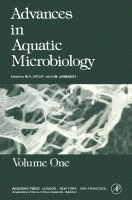Browse content
Table of contents
Actions for selected chapters
- Full text access
- Book chapterNo access
Trends in the development of ecological microbiology
S.I. KUZNETSOV
Pages 1-48 - Book chapterNo access
Inorganic nitrogen assimilation in aquatic microorganisms
C.M. BROWN and B. JOHNSON
Pages 49-114 - Book chapterNo access
Protozoan predation in batch and continuous culture
C.R. CURDS and M.J. BAZIN
Pages 115-176 - Book chapterNo access
Microbial pathogens of cyanophycean blooms
W.D.P. STEWART and M.J. DAFT
Pages 177-218 - Book chapterNo access
Methods in sediment microbiology
VERA G. COLLINS
Pages 219-272 - Book chapterNo access
Bacterial indication of water pollution
G.J. BONDE
Pages 273-364 - Book chapterNo access
Subject Index
Pages 365-378 - Book chapterNo access
Index of Authors
Page 379 - Book chapterNo access
Index of Titles
Page 381
About the book
Description
Advances in Aquatic Microbiology Volume 1 describes the characteristics of ecological niches for individual microorganisms and the intensities of individual microbiological processes in the course of turnover of various substances in reservoirs. This volume follows Volume 1 of Advances in Microbiology of the Sea book. The opening chapter presents insight to the tradition of Russian limnological microbiology followed by a discussion on conversion of inorganic nitrogen to organic nitrogen, and the microorganisms responsible for assimilatory reactions. The book considers aspects of the reduction of atmospheric dinitrogen and nitrate to ammonia and the incorporation of ammonia into organic compounds. Such considerations will relate particularly to those organisms of significance in aquatic environments. The relations between prey and predator and their significance in the investigation both the behavior of the microorganisms themselves and the prey-predator situation in general are also discussed. Chapter 4 examines how viruses, bacteria, and fungi affect the blue-green algae and the development and regulation of algal blooms. The final two chapters summarize studies in freshwater sediment microbiology and the role of bacteria in water pollution monitoring. This book caters primarily to aquatic microbiologists, but limnological microbiologists, aquatic researchers, scientists, teachers, and students with courses in aquatic microbiology will find this book invaluable.
Advances in Aquatic Microbiology Volume 1 describes the characteristics of ecological niches for individual microorganisms and the intensities of individual microbiological processes in the course of turnover of various substances in reservoirs. This volume follows Volume 1 of Advances in Microbiology of the Sea book. The opening chapter presents insight to the tradition of Russian limnological microbiology followed by a discussion on conversion of inorganic nitrogen to organic nitrogen, and the microorganisms responsible for assimilatory reactions. The book considers aspects of the reduction of atmospheric dinitrogen and nitrate to ammonia and the incorporation of ammonia into organic compounds. Such considerations will relate particularly to those organisms of significance in aquatic environments. The relations between prey and predator and their significance in the investigation both the behavior of the microorganisms themselves and the prey-predator situation in general are also discussed. Chapter 4 examines how viruses, bacteria, and fungi affect the blue-green algae and the development and regulation of algal blooms. The final two chapters summarize studies in freshwater sediment microbiology and the role of bacteria in water pollution monitoring. This book caters primarily to aquatic microbiologists, but limnological microbiologists, aquatic researchers, scientists, teachers, and students with courses in aquatic microbiology will find this book invaluable.
Details
ISBN
978-0-12-003001-9
Language
English
Published
1977
Copyright
Copyright © 1977 Elsevier Inc. All rights reserved.
Imprint
Academic Press
